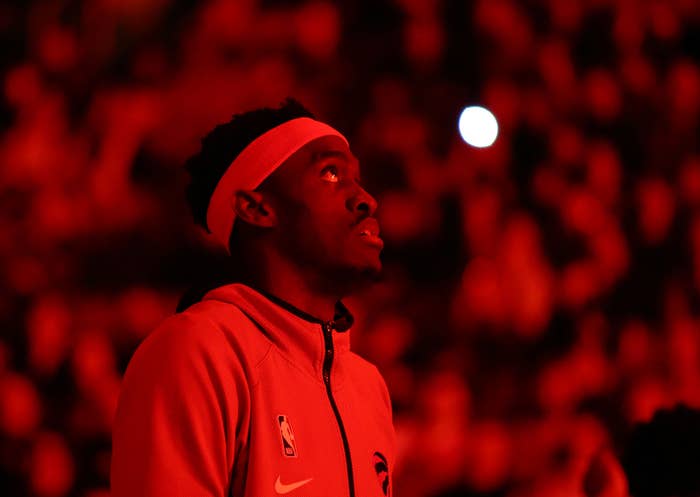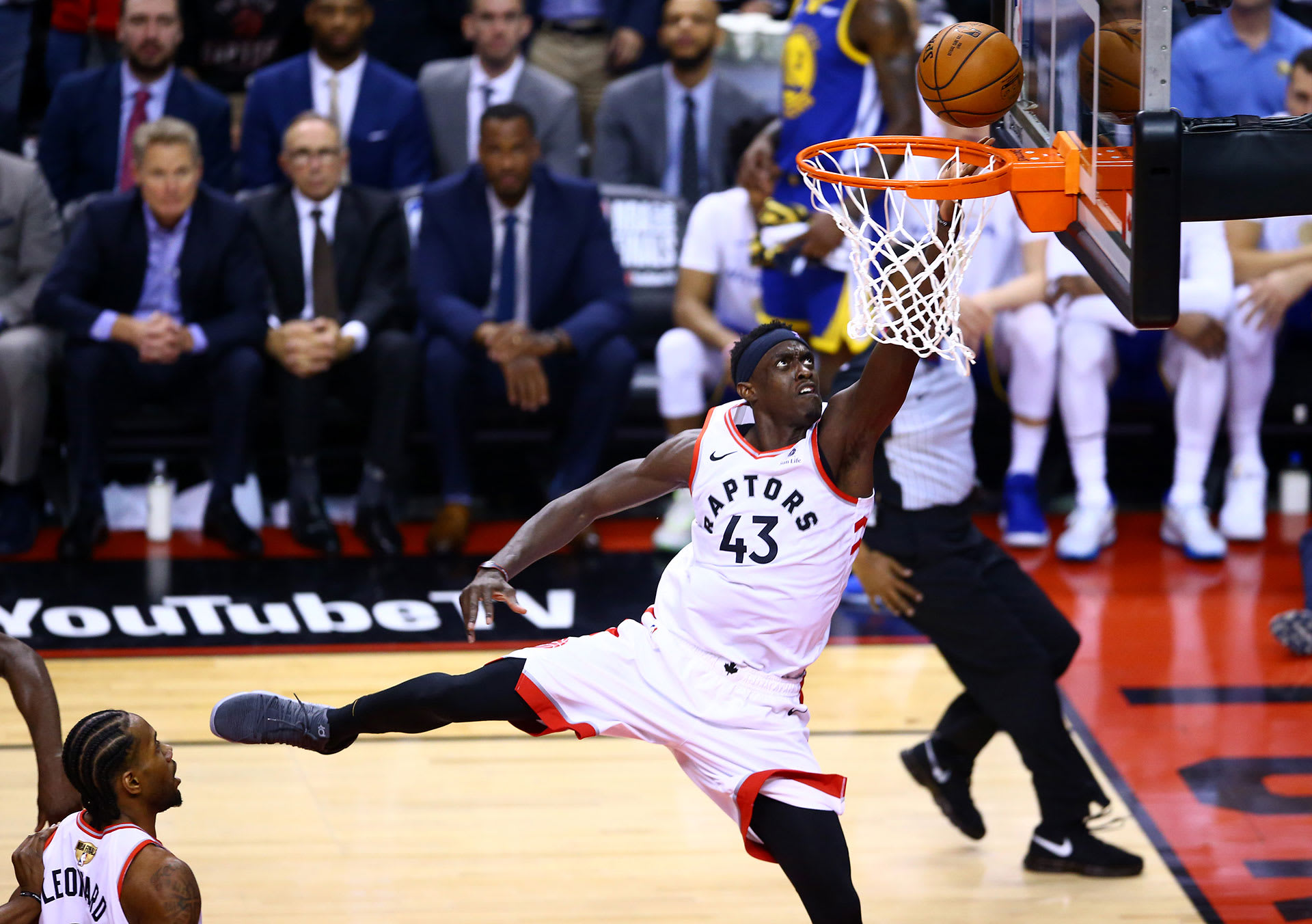
Pascal Siakam took a seat at the podium in his personally branded red hoodie with white piping across the front forming his PS logo and the Canadian maple leaf embroidered within. Over his left shoulder, a massive LED screen with the words “2019 NBA Champions – Toronto Raptors.” Now, seeking to defend their title, it was the 25-year-old who was being asked if he was ready to assume the throne as the face of the franchise.
“For me, it’s just looking back at last season and looking at things I didn’t do so well; just working on every facet of my game, trying to be a complete player,” Siakam said as he shivered in an usually cold makeshift podium space within the confines of Scotiabank Arena.
Completely unfazed or intimidated by the prospect of being the new go-to option of the defending champions, Siakam kept the narrative about what his story has always been about, getting better day in and day out. Keep the main thing the main thing and the rest will take care of itself. On the back of playing the perfect Robin to Kawhi Leonard’s Batman, Siakam has been challenged to assume the mantle as top dog, and his work over the past summer with Sacramento Kings player development coach Rico Hines has delivered results just as it has each and every summer since he’s been in the league. Averaging 23.5 points, 7.5 rebounds, 3.4 assists, a steal, and a block per game, Siakam was bestowed the honour of being named a starter in his first All-Star invite to the showcase game. The Raptors—winners of 15 of their past 16 games—are 40-15, good for the third-best record in the league, and have been the NBA’s best story.
No one on the outside thought they’d be this good after losing Leonard and Danny Green. Of course, no one thought Siakam would, either. When he was selected 27th overall in 2016, his then head coach Dwane Casey likened him to Bo Outlaw, an energy big who never averaged double digits in scoring for a season. After starting for almost half the season due to an injury to Jared Sullinger in his rookie campaign, he was sent down to the then D-League. The next season, seeking to expand his range, he missed 25 straight three-pointers between late November and December and finished the year shooting 22 percent from three, yet kept firing away knowing it was the only way he could improve.
Like so many who eventually get to the mountain top, Siakam understands it’s the biggest failures that provide the inflection points to their greatest successes.
“That’s my mindset,” Siakam said this past November. “I have to find a way to catch up to all the people that started playing when they were like five-years-old. I have a long way to go and every single day I know that, so I have to work double.
“Now it's like, I want to stay there [All-Star status]. I don't want to be there for one year. There's always something bigger to fish for, like something that you can think of that's bigger than what you're accomplishing. So, you're here, but it's like, can you stay there? That's my next question."

As a child, Siakam spent a significant portion of his time at St. Andrew’s Seminary in Bafia, Cameroon training to become a priest out of respect for his father’s wishes. Basketball was the furthest thing from Siakam’s mind—really, all he wanted to do during those days was find the back of the net with his foot.
“Scoring, that’s my thing… Didier Drogba, Samuel Eto’o, those were the guys that we looked at as kids like, ‘Man, they're doing it, and they're doing it at a high level,’” Siakam recalled. “We would see them on TV. So, it wasn't much about basketball, to be honest, it was just those type of athletes. Those guys were the guys that we looked at as kids.”
Would he like the time back so he wouldn’t feel like he has so much to catch up on now?
“If I had like a [younger] brother or somebody that I could be like, ‘Man, if we could start early, obviously start early.’ I definitely think it's right to start early,” Siakam said. “I don't know if there's advantages or not, but I think every story is different. And if you have an opportunity to start early, start early, but if you started late don't be discouraged—you can make it too.”
After making just 21.6 percent of his attempts from beyond the arc over his first two seasons, Siakam is now pulling up over defenders and draining them with regularity. Before the start of the season, he acknowledged that sizing up opponents from the middle of the floor is something he needed to add to get to the next level, and he’s gone from making just 26 percent of his non-corner threes last season to 38 percent this season. Developing that skill has forced defenders to reach out to him on the perimeter, opening up driving lanes for him to get to the basket.
“I don't think there's any ceiling. I never think that way. I never ever did that in life, period." - Pascal Siakam
While he continues to round out his game offensively, defensively, Siakam is a 6-foot-9 jackrabbit with 7-foot-3 tentacles who smothers his opponent one second before racing over to contest another player’s shot the next. He can guard the best players either at guard or on the wing as well as the occasional centre. Usually the head of Nick Nurse’s zone defence, Siakam leads the league with 5.7 contested threes per game. On average, he is contesting more shots than reigning MVP Giannis Antetokounmpo and Houston’s do-it-all defender P.J. Tucker. He has said repeatedly that he cuts himself no slack for being the offensive focal point of the team and that he wants to be great on both ends. The ambition of this man knows no bounds. He won the league’s Most Improved Player last season, and if it weren’t for the tradition of that award signifying a graduation of sorts, he’d be firmly in the running to repeat.
It’s hard to imagine there aren’t any benefits to starting out late, though. Siakam acknowledges that being as fleet of foot as he is may have something to do with the time he put in on the soccer field, and just the sheer life experience of pursuing priesthood will have taught him a great deal about the value of discipline.
“It goes both ways,” VanVleet told Complex. “He’s not jaded to certain things like those of us playing the game since we were five years old might be. The small day-to-day stuff that can get tiresome, he probably sees that stuff a little differently.”
Playing FIFA on a console has been one of his go-to activities when it’s time to disconnect—that and hanging out with his brothers. The special bond Siakam has created with VanVleet, though, has become a source of strength whenever he needs. The two have reached a point in their friendship where they talk about literally anything, from their entrepreneurial pursuits to family to favourite food spots.
“Knowing him for as long as I've known him and coming from where we came from, being in the D League and sitting on the end of the bench for a lot of our rookie year, that's a bond that you grow over time,” VanVleet said, reflecting on the relationship the two share. “We've done that, we've worked in the summer together, we've come and worked our way into the lineup, and obviously he's taken a superstar trajectory. It's just been fun to be there alongside him, and if I can stick by his side, maybe I'll stick around long enough and soak up some of that max money.”
It seems silly to already be thinking of Siakam in terms of a superstar trajectory or max money. Back in early 2018, when Siakam was gaining his first bit of notoriety league-wide as a member of the Bench Mob alongside VanVleet, there was a gift waiting for him at his locker after a game, and as DeMar DeRozan and Kyle Lowry consumed the lion’s share of the media, he quietly went about opening the small box with eyes so wide he looked as though he was about to unleash his now patented spin move. Inside was a red chili pepper key chain in the shape of the Nike swoosh, and he looked over to see if anyone noticed. There was a media member in the vicinity, who he called over and said, “Check this out—that’s crazy, right?”
You could tell it was a special moment; a little thing that perhaps not many others would get too caught up in. Don’t get it twisted—after admiring it for a few seconds, he quickly went about the rest of his post-game routine. Still, it serves as a reminder of just how far he’s come in such a short space of time, and also how appreciative he is of the little moments along the way.

Siakam signed a four-year, $130-million extension just prior to opening night, with incentives that could boost that figure if he can continue to level up. And that raises an important question looking down the line: how good can he get? All this while, fairly reasonable bars have been set and he has blown them out the water. Perhaps it’s time to get crazy—forget what previous players have taught us about progress, because as his head coach Nick Nurse often remarks, he seems to cut all of those expectations in half anyway.
“I don't think there's any ceiling,” Siakam said. “I never think that way. I never ever did that in life, period. So, there's always something bigger to look at, and I genuinely believe that.”
There are some pretty special examples of NBA players who picked up the game late and went on to become household names. How about Tim Duncan, who started swimming at the age of five and got to a point where he trained for the sport by putting in 5,000 to 8,000 metres a day, six days a week, before gravitating toward basketball and finishing his career as arguably the greatest power forward in the history of the league? Or Hakeem Olajuwon, who played soccer as a goalkeeper until the age of 15, when a basketball coach enamored by his size persuaded him to give the old orange ball and a hoop a try? Granted, both these players were top tier selections come the draft, but why should that limit Siakam’s potential? Like age, a draft number is just that. A team that just won a championship without a single lottery pick serves proof of that.
Next up for Siakam is handling double-teams better, getting off quality shot attempts in the crux of the game. It’s the most difficult part of growing in the NBA, the transition from All-Star to superstar. After shooting over 70 percent at the rim the last two seasons, he’s down to 64 percent this season. He has struggled from the mid-range as well, converting just 34 percent of his attempts—an area of the floor he considers vital to rounding out his game. These struggles with all eyes on him are necessary, though. In his bookRANGE:Why Generalists Triumph in a Specialized World, David Epstein highlights the importance of “desirable difficulties”—obstacles that make learning more challenging, slower, and more frustrating in the short-term, but can have strong long-term effects. Siakam’s usage of 28.6 percent this season is just a couple percentage points shy of what Leonard’s was a season ago. As he continues to be given every opportunity to figure it out, the hard times in the present will only make him better for the future.
Bit by bit, Siakam is looking to join the elite of the elite by being a improved version of himself today over who he was yesterday.
“To be honest, I see more championships, I see MVP, I see so much more that I can accomplish,” he said. “There's no reason to be satisfied. There's no reason to be complacent. So many people have been an All-Star before. What else can there be?”
It’s going to be a fun ride finding out.

